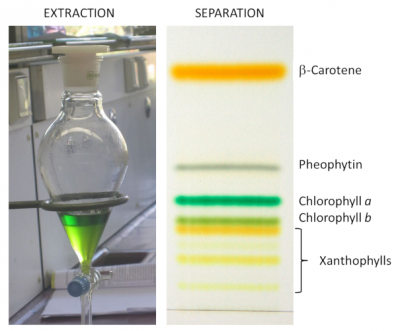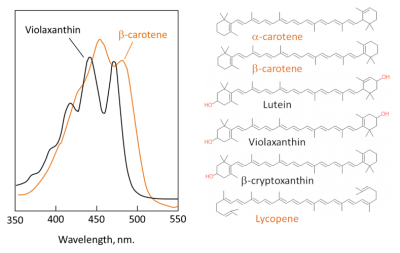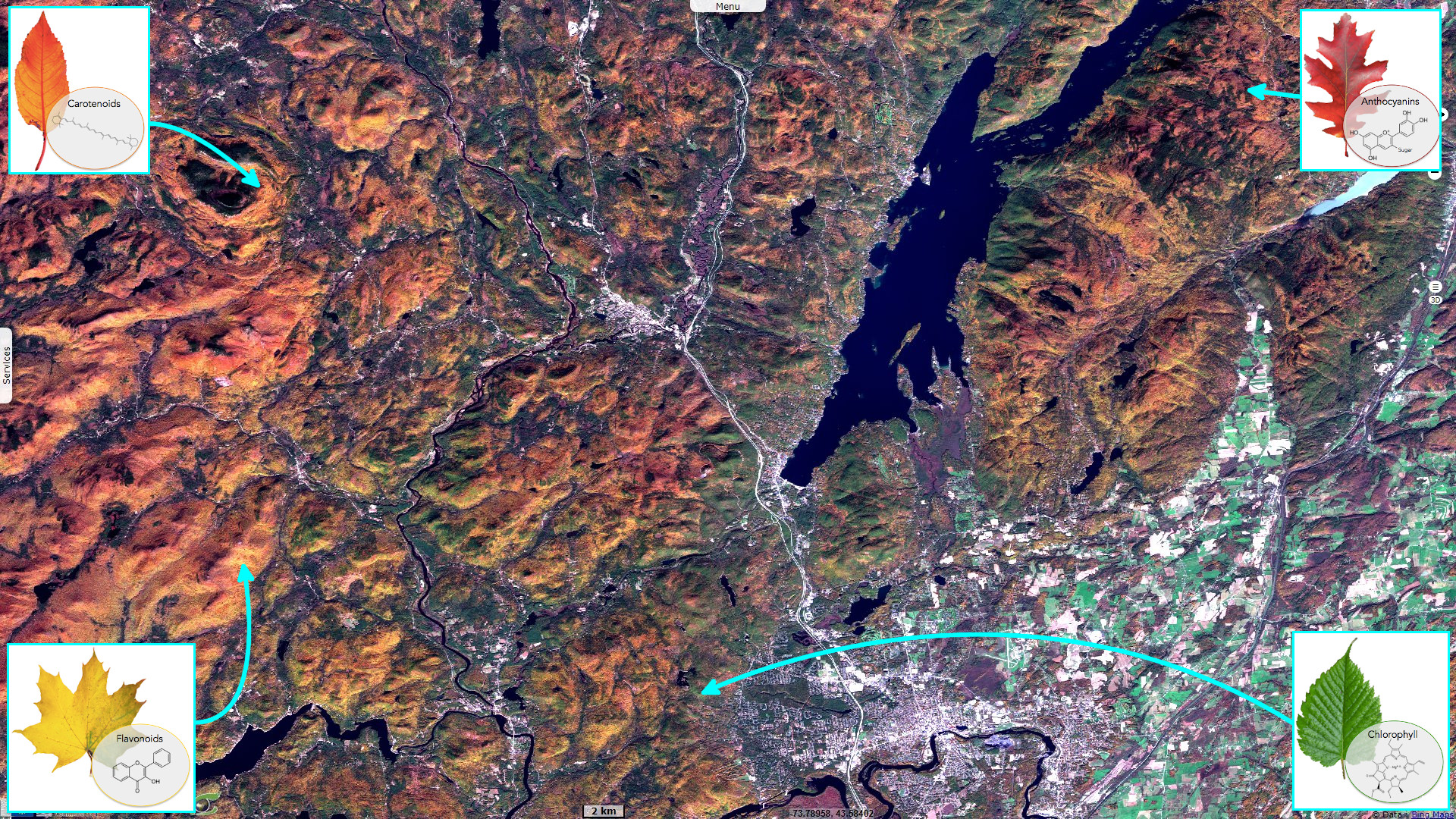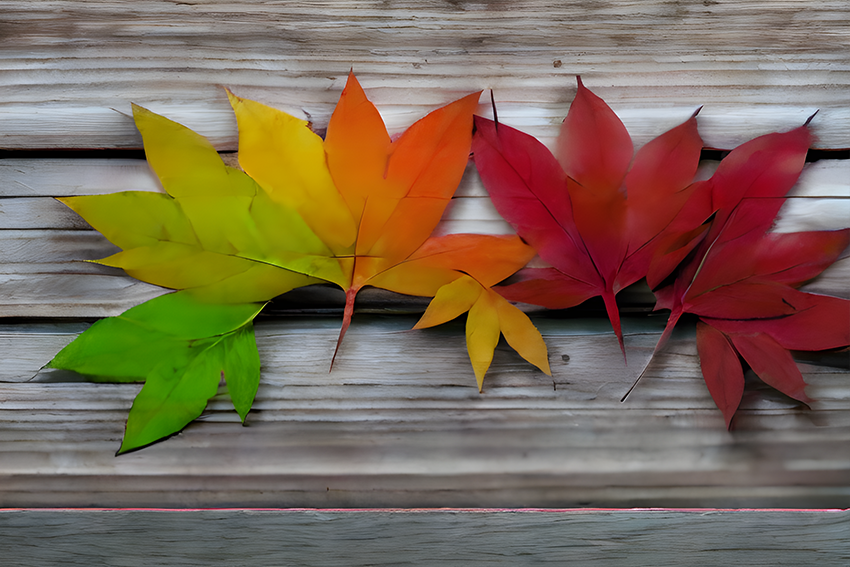Leaves pigments highlighted by the colours of autumn in north-east United States
Sentinel-2 MSI acquired on 23 July 2022 at 15:36:11 UTC
Sentinel-2 MSI acquired on 05 October 2022 at 16:01:19 UTC
...
Sentinel-2 MSI acquired on 22 October 2022 at 15:53:09 UTC
Sentinel-2 MSI acquired on 10 November 2022 at 15:36:01 UTC
Sentinel-2 MSI acquired on 05 October 2022 at 16:01:19 UTC
...
Sentinel-2 MSI acquired on 22 October 2022 at 15:53:09 UTC
Sentinel-2 MSI acquired on 10 November 2022 at 15:36:01 UTC
Keyword(s): Seasons, forestry, vegetation, land, biodiversity, United States, USA
"Plants produce an incredible diversity of pigments linked to many physiological and/or biological functions: photosynthesis, reproduction (to attract insects when pollinating flowers, for example). There are several types of pigments in leaves, mostly chlorophylls, carotenoids and anthocyanins.", writes encyclopedie-environnement.org.
"Chlorophyll is responsible for the green colour of leaves, but in autumn, some forests or crops lose their green colour and turned spectacularly coloured. In these leaves, chlorophyll disappears while other pigments – such as carotenoids, naturally present all year round in the leaf – have not yet disappeared. This process begins as the length of the day decreases and temperatures drop. When the chlorophyll level decreases, the synthesis of anthocyanins – which are responsible for the red colour of the leaves – increases. These are the initial stages of leaf senescence that will lead to leaf fall."
Chlorophyll is essential for life on this planet, because it is one of the few existing molecules that are able to channel energy into biological systems. Andy Brunning sums up the process at molecular level on compoundchem.com: "The colour causing molecules in autumn leaves contain systems of alternating double and single bonds – this is referred to as conjugation. A large amount of conjugation in a molecule can lead to them being able to absorb wavelengths of light in the visible spectrum. This leads to the appearance of colour."
"Chlorophyll is contained within chloroplasts in the leaf cells, and is an essential component of the photosynthesis process via which plants use energy from the sun to convert carbon dioxide and water into sugars." A variety of parameters affect tree colour during the season: tree species, altitude, latitude, orographic shadow, sunny slope / shady slope... "For the production of chlorophyll, leaves require warm temperatures and sunlight – as summer begins to fade, so too does the amount of light, and thus chlorophyll production slows, and the existing chlorophyll decomposes. As a result of this, other compounds present in the leaves can come to the fore, and affect the perceived colouration."
Alice Breda adds on la-plumeria.com: "Plants indeed invest a good amount of energy in replacing damaged chlorophyll with fresh chlorophyll molecules in order to keep photosynthesis efficient. During autumn, when light and heat are lacking, plants don’t have enough energy to invest in chlorophyll production."
The lesser known xanthophylls (yellow leaf in greek, as opposed to Chlorophyll green leaf) group is not visible year-round, yet is is present in the healthy leaves. Encyclopedie-environnement.org
explains: "Xanthophylls – carotenoids which contain oxygen – are a subclass of carotenoids essential for photosynthesis and photosystem protection. Main xanthophylls in leaves are lutein, zeaxanthin, violaxanthin, etc. Pigments absorb mainly in the blue wavelengths, hence their yellow colour. Xanthophylls are precursors of plant hormones (abscisic acid in particular)."
Andy Brunning completes:
"Carotenoids and flavonoid pigments are always present in leaves, but as chlorophyll is broken down in the autumn their colors come to the fore. One of the major xanthophylls, lutein, is also the compound that contributes towards the yellow color of egg yolks."
Carotenes, carotenoids which do not contain oxygen, are yellow to orange or red pigments derived from isoprene. Alice Breda describes their role: "Different colors absorb and filter different light wavelengths, which otherwise might damage essential life molecules – DNA, RNA and proteins – inside leaves. This is why plants contain these pigments at any time of the year, even when their color is not visible because is hidden by the greeness of chlorophyll."
"The β-carotene does not actively contribute to photosynthesis but absorbs the excess energy from the chlorophyll in order to avoid the formation of reactive oxygen species which would destroy the leaf.", adds encyclopedie-environnement.org about a famous member of this family. Andy Brunning completes: "It is one of the most common carotenoids in plants, and absorbs green and blue light strongly, reflecting red and yellow and causing its orange appearance. Carotenoids in leaves starts degrading at the same time as chlorophyll, but they do so at a much slower rate; some fallen leaves can still contain measurable amount." "Notable carotenoids include beta-carotene, the cause of the orange colour of carrots and lycopene, which is also responsible for the red colour of tomatoes."




Left: Extraction and separation of leaf pigments. Right: Absorption spectrum of β-carotene and violaxanthin - Source: encyclopedie-environnement.org.
The final colour of the cycle is the red of anthocyanins, presented by encyclopedie-environnement.org: "Anthocyanins are responsible for the pinkish-red colour of most flower petals, fruits and almost all red leaves in the fall. Anthocyanins absorb visible light in the blue-green wavelengths."
Andy Brunning precises their mecanism: "Anthocyanins, are also a member of the flavonoid class of compounds. Unlike carotenoids, anthocyanins aren’t commonly present in leaves year-round. As the days darken, their synthesis is initiated by increased concentration of sugars in the leaves, combined with sunlight. In terms of their contribution to the colour of autumn leaves, they provide vivid red, purple, and magenta shades. Their colour is also affected by the acidity of tree sap, producing a range of hues."
"Anthocyanins are known for their beneficial effects in our diets for their antioxidant properties. Some speculate that the red color act as a warning signal to discourage herbivorous insects, or as a further protection for a less and less efficient photosynthetic systems.", writes Alice Breda about their role.
The chlorophyll production is detailed by Aaron Roth, a biologist at Northeastern University: "Deciduous trees—the kind that have broad leaves, such as maple, oak, and hickory trees—lose water through their thin, delicate leaves throughout the year. This isn’t a problem in the summer, when trees can pull water up from their roots and there’s enough sunlight to be absorbed by the hungry plants." "Trees produce chlorophyll, a green pigment that absorbs light. That light is then turned to energy that feeds the trees. During the summer growing season, trees produce chlorophyll as fast as they use it."
Alice Breda
explains the senescence: "Triggered by external factors, the leaf senescence that leads to color change and leaf fall is actually finely controlled by plants at the genetic and physiological level. The reason why plants lose their leaves is to replace them with fresh and more efficient ones. Evergreen plants such as conifers (pines and firs, for instance) do it continuously throughout the year, while deciduous plants lose all of them at the same time just before the critical season. In our climates, this corresponds to winter, during which light availability is low and the risk of freeze damage is high. Therefore, leaf maintenance costs outweigh the benefits of photosynthesis, which is limited by the length of nights and small amount of light."
"In their survival strategy, plants perceive the lengthening of the daily dark period that occurs in autumn and start dismantling leaf structures in order to recycle their constituents. At the same time, the transport of nutrients towards leaves becomes limited by structural changes occurring at the base of each leaf, between the petiole and the branch to which it is attached. Here lies the abscission zone, a layer of cells that is degraded as autumn proceeds. At the end of the process, the connections between leaves and branches are so weak that some wind is enough to make them fall."
"Trees drop their leaves to stanch the loss of water by evaporation during the winter. Trees slow down their metabolism (the production of chlorophyll) in order to conserve energy for the winter." concludes Aaron Roth.












